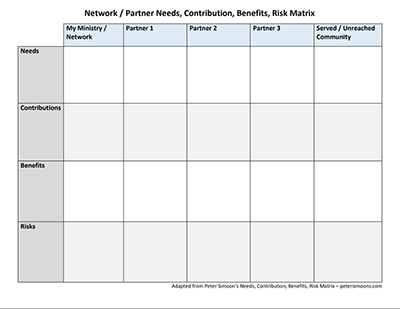“A needs and contributions matrix can be a very helpful tool to prepare for your meetings with a partner, even before you show up for the first meeting. The matrix can also be used for assessing an existing partnership.”
Summary
Planning a partnership is much like planning a community potluck or holiday family meal. Everyone is expected to contribute to the meal and by working together dishes are coordinated and the load is shared. This of course takes communication and planning.
Likewise, when forming, entering, or re-evaluating a partnership or network, it is vital to take the time to have a clear conversation about what each partner needs, can contribute, how they benefit, and any risks that would be incurred by a potential partnership.
Expectations, needs, contributions, benefits, risks etc. all need to be discussed and understood alongside a clear collective purpose, vision, and outcomes. Often partnerships craft a joint statement that describe the needs and contributions of each partner. This helps to build alignment, establishes clear expectations, and builds trust.
This matrix will help partners clearly and transparently state their needs and wants, clarify expectations, identify a partner’s contributions, highlight individual and collective benefits, and surface any risks that need to be considered.
This Needs, Contribution, Benefits, Risk matrix was developed by a Peter Simoons, a Dutch Business Alliance Consultant. He generously gave us permission to adapt it for our network context and purposes. Please continue to give him credit for this tool as you adapt and use it. A citation and website is provided below.
How to Use the Matrix
- Provide each partner with a copy of the matrix before the meeting or discussion will take place.
- Have each partner complete the matrix for themselves, their partner, and the community you are serving or reaching. You may need to make some assumptions or guess what the other partner or community needs, can contribute, how they will benefit, and any risks.
- Come together and take turns presenting, sharing, and updating your matrix with the partner or group.
- This collective conversation is the most important part of this process. Make sure to give enough time for this conversation to take place without being rushed or hurried. Meeting facilitators will want to ensure that participants approach the conversation with curiosity and a willingness to listen deeply to each other.
Key Ideas
- Seek to build common ground, transparency, and trust by sharing everyone’s needs, contributions, benefits, and risks.
- This matrix can be used during the formation of a partnership, the addition of a new partner, or to re-assess a network and the extent to which is it meeting the network and partners outcomes and expectations.
Citation / Download
- Peter Simoons. Needs, Contributions, Benefits, Risks Matrix. Blog at petersimoons.com. October 28, 2019.
- Download: Needs, Contribution, Benefit, Risk Matrix (MS Word)
- Download: Needs, Contribution, Benefit, Risk Matrix (PDF)
Related Resources
- Phill Butler – Partnership Essentials Video Series – Due Diligence (Video)
- Janice K. Popp – Ten Questions to Ask Before Forming a Network
- P. James – The Exploration Phase (Video)
- visionSynergy – Tool – Exploring Inter-Network Collaboration


